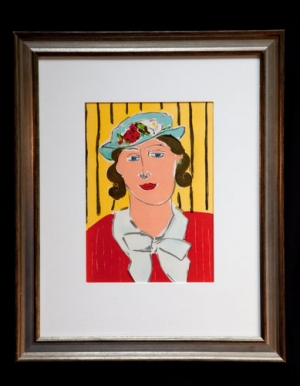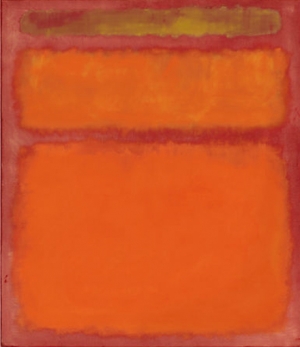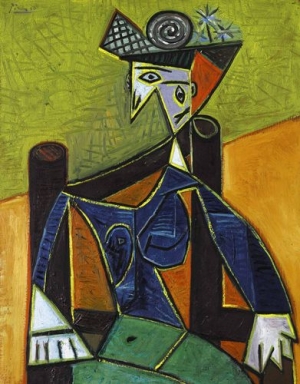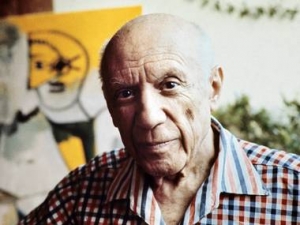|
Displaying items by tag: Picasso
Taking over two galleries at New York City’s Morgan Library & Museum, Dürer to de Kooning: 100 Master Drawings from Munich, spans the sixteenth through the twentieth centuries. The show includes rarely seem works by old masters such as Michelangelo, Rembrandt, Raphael, and Rubens as well as nineteenth century sheets by van Gogh and contemporary works by Pablo Picasso, David Hockney, and Georg Baselitz. The drawings, which are on loan from the Staatliche Graphische Sammlung in Munich, have never before been on view in the United States.
Comprised of a complex of buildings on Madison Avenue, the Morgan began as the private library of the financier Pierpont Morgan. In 1924, eleven years after Pierpont’s death his son, J.P. Morgan, Jr., turned the library into a public institution.
100 Masters will be on view through January 6, 2013.

Six years ago wholesale powerhouse, Costco, stopped selling fine art amid allegations that two Picasso drawings sold on their online store were fakes. The company recently decided to give the venture another go adding “Fine Art” as a category in their “Home & Décor” section. Nestled between “Bathroom,” “Bedding,” and “Kitchen & Dining,” the foray into the art market seems to be going well. In the past two weeks or so, 8 out of the 10 have sold including a framed screen print by Andy Warhol for $1,450 and a framed lithograph by Henri Matisse for $1,000.
The works are supplied by Greg Moors, an art dealer based in San Francisco who provided Costco with art when they first launched the department in 2003. Driven by the notion of financially accessible art, Moors dismissed the peculiarity of a discount warehouse store selling fine art. In fact, this practice is not exclusive to Costco. Between 1962 and 1971, Sears sold over 50,000 works by such artists as Picasso, Rembrandt, Chagall, and Whistler as part of the Vincent Price Collection of Fine Art. Customers could even buy works on layaway.
Although he did not supply the store with the questionable Picassos, Moors is very careful about what is available via Costco. Most of the works are unsigned to avoid questions about the signatures’ authenticity. He is also attempting to sell the works of more living artists and is avoiding artists who are known to have a proliferation of fakes circulating in the art market.
Picasso’s lovers, Richard Serra's steel and Andreas Gursky’s yacht-studded Monaco are the highlights of a $130 million trove Gagosian Gallery is taking for its first expedition to Brazil next month.
The occasion is the second annual ArtRio in Rio de Janeiro, a fair spread over 7,500 square meters (80,730 square feet) in four warehouses on Guanabara Bay. It will feature 120 galleries, including David Zwirner and White Cube, as well as events hosted by Christie’s and Sotheby's. The size and participants reflect a growing interest in the world’s sixth-largest economy.
Artists and collectors looking to cash in on the reported one percent's run on the international art market can take cues from a recent Washington State University study on auction house sales of paintings by Picasso, Magritte, Munch, and a dozen other impressionist and modern masters. Among the preliminary findings, a single percentage point increase in Google hits on the artist—the assigned indicator of popularity—corresponded to a chunky price increase of 38 percent.
It's a story straight out of Antiques Roadshow. The Evansville Museum recently discovered that a work of art sitting in storage for nearly half a century was a rare and valuable work created by Picasso.
It won't be here long, however.
The cost of caring for such a piece is too great for an institution with a limited budget and the board of trustees on Monday decided to sell it through a New York auction house. The board’s action was approved by the museum’s members at a meeting held Tuesday. The trustees voted to sell the piece through Guernsey's, a New York auction company that was trying to track it down.

As the world economy began to tank about five years ago, a curious thing happened at the top level of the international art market: It started to boom. At the annual spring art auctions at Sotheby's and Christie's in New York and their branches around the globe, deep-pocketed bidders snapped up Braques and Bacons, Klimts and Kandinskys, often at record prices.
Now with the global recession officially over but the American and European economies still shaky, auction records for blue-chip modern and contemporary art continue to be shattered. Just a few months ago, a pastel version of Edvard Munch’s "The Scream" (1895) fetched an astounding $119.9 million at Sotheby’s, by far the highest price ever paid at auction for a work of art, surpassing the winning bid of $106.5 million for Picasso's "Nude, Green Leaves and Bust" (1932) at Christie’s two years earlier. A week after the gavel fell on the Munch, Mark Rothko's "Orange, Red, Yellow" (1961) went for nearly $87 million, the artist’s personal best at auction.
Managers at Edinburgh airport appear to have been learning the intricacies of public relations at the feet of Argyll and Bute council, quickly if belatedly reading the chapter marked: The Lessons of Martha Payne.
With all the deftness of a fully-laden Boeing 747, the airport today executed a sharp u-turn on their decision on Tuesday to cover up and then ban a poster carrying a widely-celebrated nude by Picasso from their international arrivals lounge.
Sometime next fall, the Alfred Stieglitz collection, Fisk University’s renowned art exhibit, will be packed up into crates and trundled off to Arkansas.
It will stay there for two years as part of a sharing agreement that, until recently, was caught up in what appeared to be an unyielding battle between ownership rights and financial distress.
The university, which has long run a $2 million annual deficit, agreed to sell half ownership rights of its $74 million Alfred Stieglitz collection for $30 million to a museum opened last fall in Bentonville, Ark., controlled by Wal-Mart heiress Alice Walton, according to an agreement filed in Davidson County Chancery Court.

A 1941 Picasso to be offered at Sotheby’s tomorrow night with a $20 million to $30 million presale estimate was damaged while in the care of New York’s Acquavella Galleries, according to a lawsuit filed by the insurer of its owner, Ted Forstmann.
Forstmann, a financier who died last year, lent the portrait of Picasso’s lover, Dora Maar, to the Upper East Side gallery for a show in October 2008, according to the complaint filed in New York State Supreme Court in Manhattan.
“While in the care, custody, and control of Acquavella, the work was physically damaged,” American International Insurance Co. said in the October 2009 complaint.
The insurer paid Forstmann $7.5 million for damages to the painting, called “Femme Assise dans un Fauteuil,” according to the complaint. Sotheby’s “condition report” for the work, which the auction house makes available upon request, said it’s “in very good condition.”
Forstmann bought the work from Acquavella in 2001, according to Sotheby’s (BID) catalog.
“The surface is unvarnished and displays a rich and textured impasto,” Sotheby’s condition report said. “There is a two-inch repair below the figure’s neck where the canvas has been stitched. This restoration is of the highest standard and not visible to the naked eye.”

In 1905, when Britain had yet to encounter the bright, multi-perspective works of Pablo Picasso, an art critic predicted a great reception for him in the UK, on the basis of a brief but well-received exhibition across the Channel, in Paris.
Théodore Beauchesne couldn't have been more wrong. His words would sound absurdly optimistic for decades to come. Picasso had not yet shown any of his Cubist paintings on British shores, but when he did, five years later in 1910, they were met with hilarity, anger and blank-faced bemusement. The lack of comprehension would build up its own momentum of suspicion, hostility and intense dislike over the next three decades, culminating in withering words from Winston Churchill.
From the moment that the Bloomsbury group's Roger Fry staged a post-Impressionist show featuring the Spanish artist's paintings in London in 1910, right up to the nail-in-the-coffin statement from Churchill in 1949 who declared that he would like to give the artist a kick up the backside, Picasso was reviled and rejected by the British establishment, even as he was being snapped up by American collectors and adored across Europe.
The Picasso-haters were many, but the words of Churchill – himself a painter, though hardly in the same league – were among the most vitriolic. They were conveyed by Alfred Munnings, president of the Royal Academy, speaking at a gala dinner in 1945. In his speech, broadcast by the BBC four years later, he said that when Churchill had asked "Alfred, if you met Picasso coming down the street would you join me in kicking his... something, something?" he had heartily agreed that he would, to the great amusement of the audience.
Evelyn Waugh, accustomed to signing off letters with the valedictory words "death to Picasso", had by then also given his critical appraisal of Picasso: "Senor Picasso's paintings cannot be intelligently discussed in the terms used of the civilised masters."
Long before this schoolboy mockery, which was as political as it was jingoistic – the conservative establishment disapproved of Picasso's membership of the Communist party, and were suspicious of the "foreign" art movement that he represented – the British art world was confounded by his non-representational work.
And just as there were different generations of dissent, from 1910 until the post-war period, so there were corresponding generations of support and admiration, however small a circle this latter clique formed at first.
An exhibition to be staged by Tate Britain this month, entitled Picasso and Modern British Art, will reflect back on the initial antipathy and subsequent acceptance of Picasso's groundbreaking Cubism. The show will mark seminal moments and influences in Britain in relation to Picasso, including the inflammatory tour of his large-scale work Guernica, which captured the violence of the Spanish Civil War, but came to epitomise the destruction of the Second World War. The exhibition will show Picasso's work alongside that of seven British artists he influenced: Duncan Grant, Wyndham Lewis, Ben Nicholson, Henry Moore, Francis Bacon, Graham Sutherland and David Hockney.
Chris Stephens, a co-curator of the show, said that Britain was not the only country to balk at Picasso's work at the beginning. Much of the dislike was down to miscomprehension. The Modernist movement and Cubism, in which Picasso led the way, were new to Europe.
"From very early on, Picasso became the figurehead for Modern art so he is the lightning rod for the hostility for something bigger," says Stephens.
Picasso's first solo show, in 1912 at the Stafford gallery, was comprised mainly of drawings from the rose and blue periods; a second post-Impressionist exhibition followed at the Grafton gallery the same year. This was the first real opportunity that Britain had had to come face to face with work which appeared bizarrely abstract to an audience accustomed to representational art.
The earliest generation of supporters who attempted to habilitate him into the British art scene included the Bloomsbury group's Roger Fry and Clive Bell. Although the group was to become the intellectual aristocracy of the 1930s, they were, at this point, small, obscure and lacking influence. What's more, Fry might have been a great fan but he did not fully understand Cubism himself, and described it as abstract art.
Greater awareness came by the 1920s. Artists of note began to visit Picasso in Paris and the south of France, and there was the sense of a hard-and-fast British clique building up. Ben Nicholson and Barbara Hepworth were among these admirers. Nicholson talked of a particular shade of green in one of Picasso's paintings [art historians cannot establish which] that became a benchmark of quality for him. Francis Bacon was so moved when he saw Picasso's paintings in Paris that he decided, once and for all, to pursue a vocation as a painter, rather than as an interior decorator.
|
|
|
|
|